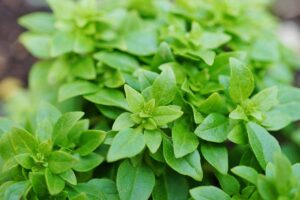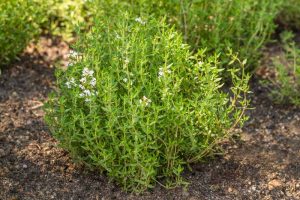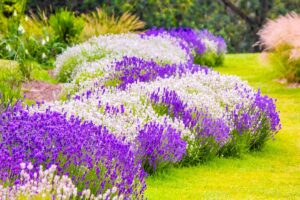Salvia elegans
With its showy red flowers and irresistible scent, pineapple sage is an aromatic star of the summer garden.
Plus, if you grow this elegant plant with your herbs or veggie crops, it will attract a multitude of pollinators and beneficial insects with its bright blooms.

We link to vendors to help you find relevant products. If you buy from one of our links, we may earn a commission.
And if you love cultivating your own herbs to use in culinary creations or homegrown herbal teas, this aromatic plant’s tropical-fruit scented foliage will be a delight that is simply… sensual.
If it sounds too good to be true, just wait, there’s more – this beauty of a plant is easy to grow too.
What You’ll Learn
What Is Pineapple Sage?
Our sensory appreciation of this herb may begin with the visual – pineapple sage (S. elegans) is an herbaceous, semi-woody aromatic plant that features fantastic spikes of red blooms.
Grown as a small shrub, tender herbaceous perennial, or annual, this plant reaches three to five feet tall and has a three- to four-foot spread.
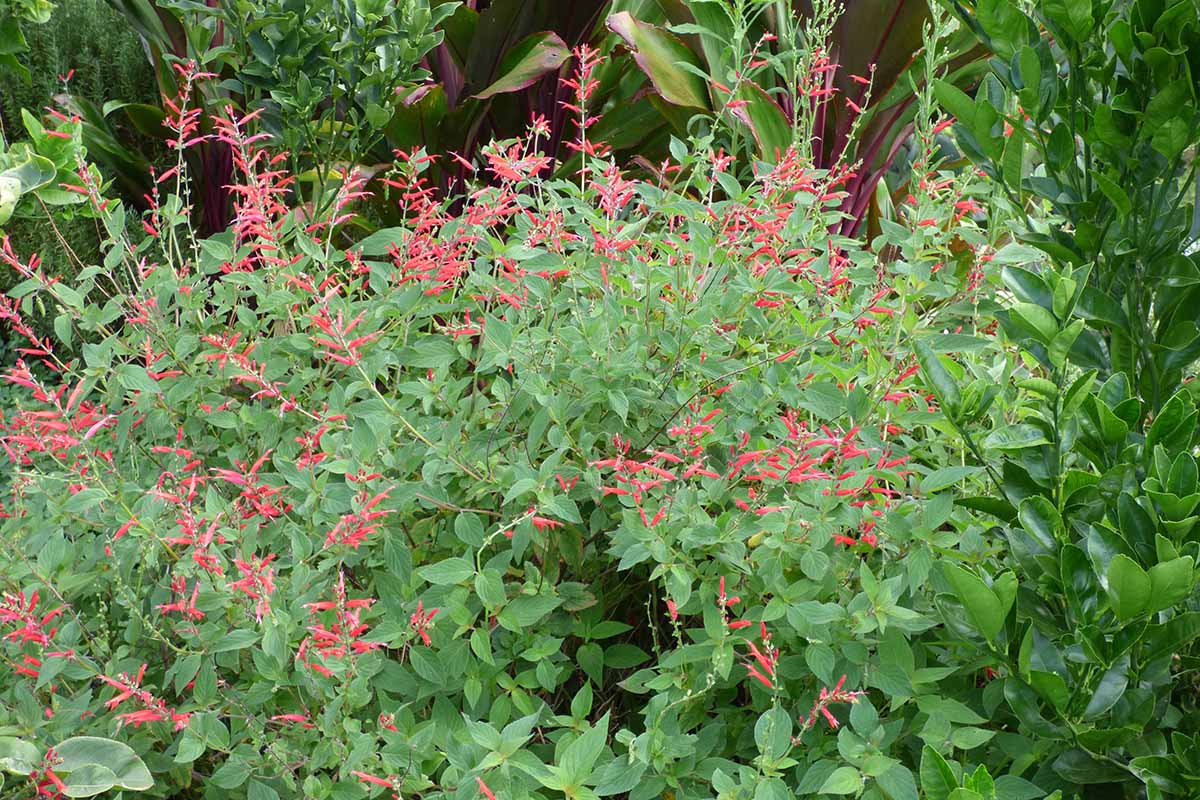
The leaves of this herb grow up to three inches long and two inches wide. Elliptical to triangle shaped and pale green in color, they are held opposite on stems that are square when viewed in cross section.
After examining the plant’s physical attributes, next comes the sensory overload – this herb’s foliage is extremely fragrant, giving off a mouth-watering, pineapple aroma that is even stronger when leaves are rubbed.
I dare you to give these leaves a sniff and not close your eyes in pure bliss.

Shortly after recovering from this indulgent waft, you may notice that to the touch, the short hairs on the herb’s foliage give the leaves a soft, slightly velvety feel.
While any plant this fragrant could be appreciated for none other than its deliciously scented foliage, there’s more.
Let’s come back to the cherry on top of the (pineapple) cake, so to say – a long spike of eye-catching, bright red flowers.
These showy, one-inch, tubular and lipped flowers are borne on spikes that are eight to 10 inches long.
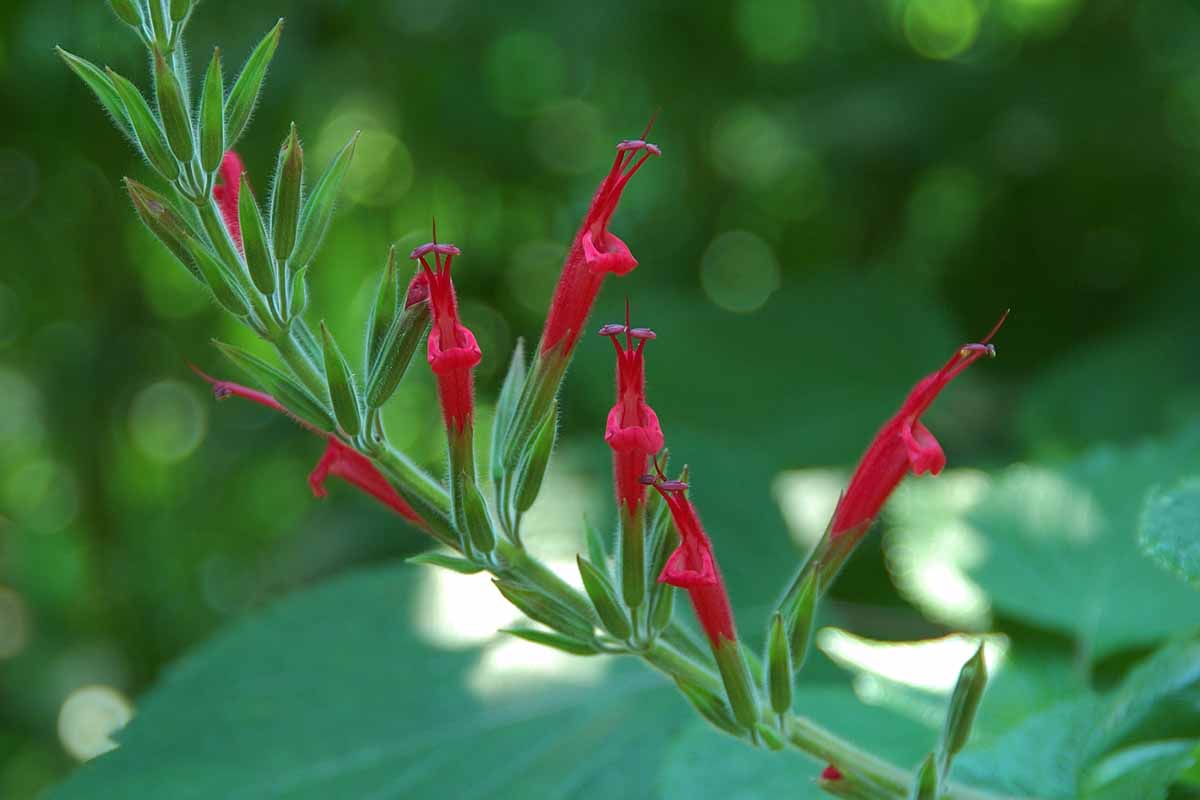
If you’ve tried cultivating this herb before and it’s failed to bloom for you, here’s why: it’s a short-day bloomer, so flowering won’t take place until after midsummer.
Some gardeners simply don’t have a long enough growing season for the plant to fully mature.
Feel like I just burst your bubble? Don’t worry, I’m about to un-burst it – there are cultivars of this herb that bloom much earlier and are better adapted to shorter growing seasons.
Underground – not a place many gardeners think about when contemplating their herbs – these plants have a clumping growth habit and can spread via subterranean runners.
This will be good to know for those of you in warmer climates, who are growing this species as a permanent feature of your landscaping.
Now, just so we are all on the same page, let’s clear up some potential identity crises that might happen with this herb.
Pineapple sage looks similar to another common offering at garden centers, a species described as S. splendens and commonly known as “scarlet sage.”
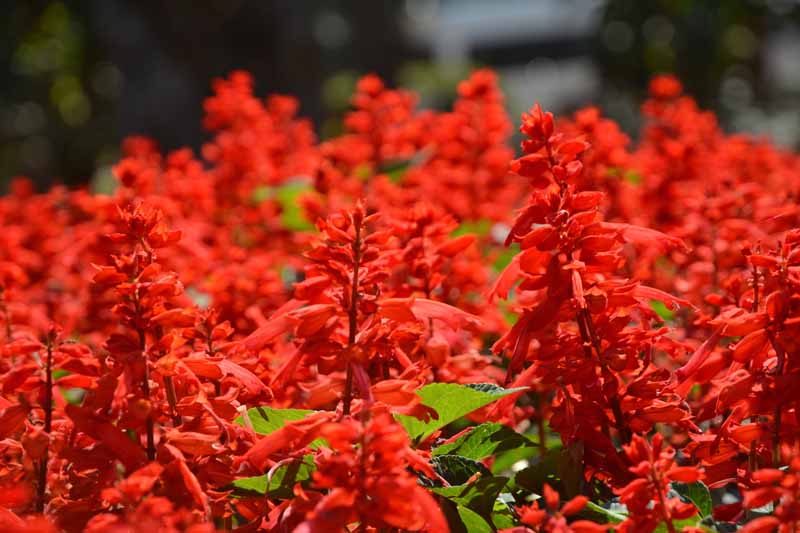
The blooms of this other sage species are arranged more densely on their spikes – and this one has no fragrance of interest. When examined side by side, pineapple sage and S. splendens are fairly easy to differentiate.
However, and especially if you enjoy foraging for food among edible wild and cultivated plants, be aware that there are many different types of salvias with red blossoms, and not all of these are edible.
One in particular is S. coccinea, a plant that is quite difficult to distinguish from the subject of our article by sight alone, but which has no fragrance and is not edible.
If in doubt about the plant’s identity, be sure to rub its leaves before sampling to verify that the plant in question is indeed pineapple sage.
If you rub its leaves and smell that distinctive tropical fragrance on your fingertips, you’ll know you have the right plant.
Cultivation and History
Pineapple sage is native to Mexico and Guatemala, where it grows at high elevations of 6000 to 9000 feet, at the edges of pine and oak woodlands.
Not surprisingly, this herb comes from a family of fragrant plants, the mint family or Lamiaceae, and counts among its sweet-scented relatives other herbs like peppermint and spearmint, but also lavender, bee balm, and catnip.
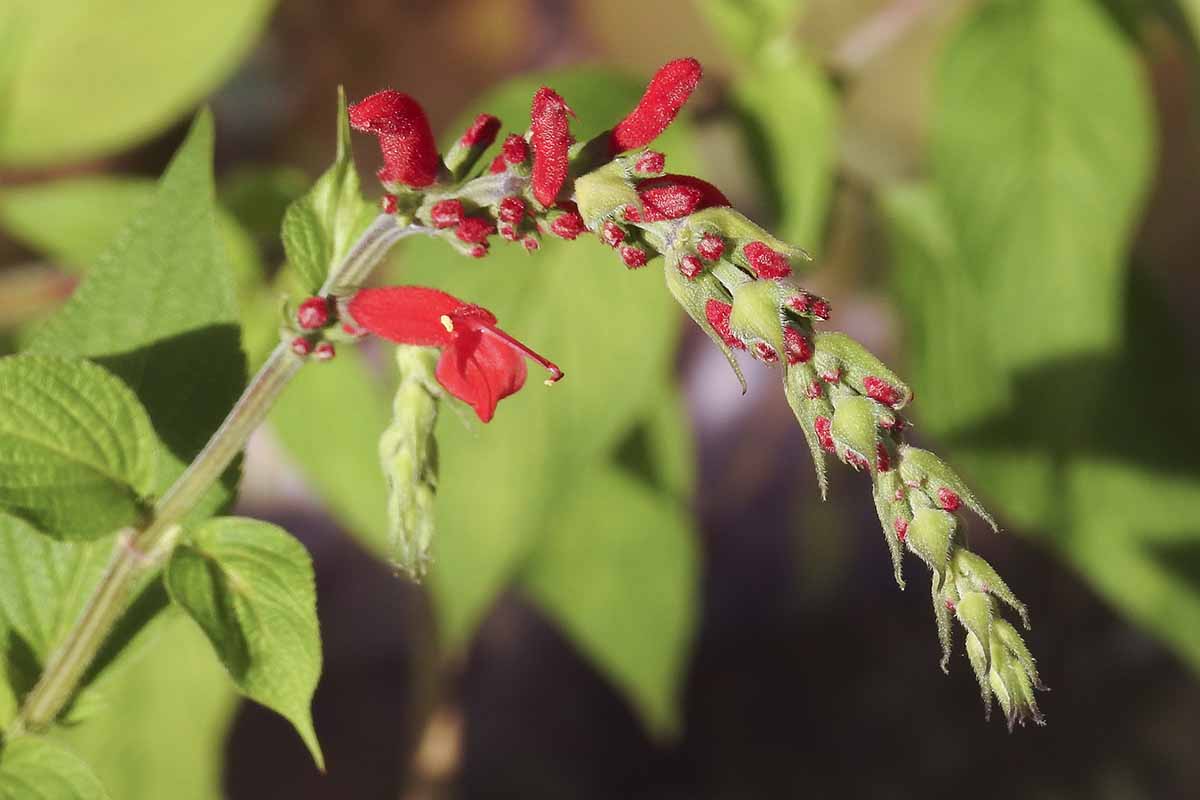
S. elegans was first described in botanical literature in 1804. Throughout the 1800s, the herb clearly gained some interest among horticulturalists.
In volume 150 of Curtis’s Botanical Magazine, published in 1879, Sir Joseph Dalton Hooker describes it as “amongst the collections of almost all the botanical travellers of [Mexico].”
While the herb’s official scientific name is Salvia elegans, this plant has also been classified botanically as S. rutilans and S. incarnata, both of which are considered synonyms.
The species name “elegans” means (as you might expect) elegant, fine, or handsome – one glance at it and I bet you’ll agree with those who bestowed this herb with its specific epithet.
Broadening our view to the genus, the Latin name “salvia” means “to heal” – which brings us to our next subject, this herb’s edible and medicinal qualities.
Pineapple sage is prized as a culinary herb for its edible leaves and flowers. Both the flowers and the leaves can be used to make teas or added to salads, baked goods, cheese spreads, gelatin desserts, or savory dishes.
As for medicinal uses, in Mexico, this plant has been used in traditional medicine to calm the central nervous system.

According to T. K. Lim in their book “Edible Medicinal and Non-Medicinal Plants, Volume 7: Flowers,” available via Amazon, research on this herb has shown it to have antidepressive and blood pressure lowering properties, among other benefits.
Pineapple sage grows as a perennial or small woody shrub in USDA Hardiness Zones 8 to 10.
Some gardeners in Zone 7 are able to keep these herbs alive from year to year by diligently applying mulch before winter sets in.
Pineapple Sage Propagation
Pineapple sage can be propagated via division, cuttings, or from seed.
However, the seeds of this herb are extremely difficult to source, so your most likely option will be propagating it via cuttings or division.
Let’s start with propagating new plants from cuttings.
From Cuttings
Spring and summer are good times to start new plants from cuttings, but you can also do this in late summer or early fall.
This will allow you to overwinter a small specimen indoors to ensure you have a continual supply from year to year.

If growing plants from cuttings to overwinter, make sure to allow enough time for the herbs to take root before your first frost.
In addition to a mature plant to take cuttings from, for this project you’ll need small two- or four-inch nursery pots (one per cutting), garden pruners or a pair of scissors, rooting hormone (optional), and growing medium, such as peat-free Organic Mechanics Container Blend Potting Soil.

Organic Mechanics Container Blend Potting Soil
You’ll find Organic Mechanics Container Blend Potting Soil in a 16-quart bag from the Organic Mechanics Store via Amazon.
Start by filling the nursery pots with planting medium. Don’t fill the pots up to the rim. Instead, leave an inch between the top of the soil and the rim of the pot.
Go ahead and moisten the growing medium.
Next, poke a hole in the soil using a garden dibber, a chopstick, or your finger. Center the hole in the middle of the pot.
Now it’s time to take the cuttings.
Be forewarned that not all cuttings will survive, so try to root extras in case a few fail to root successfully.
Clean and sterilize your garden pruners to minimize the possibility of spreading pathogens – you can do this by wiping the blades down with hydrogen peroxide or rubbing alcohol.
Next, take cuttings with at least three or four sets of leaves.

Remove the leaves from the two bottom nodes – you can use these leaves to make yourself a nice cup of herbal tea if you’d like!
While this next step isn’t obligatory, to increase your chances of successfully rooting these cuttings, apply rooting hormone to the stem wounds.
I like Olivia’s Cloning Gel, which is available in two-, four-, or eight-ounce bottles via Arbico Organics.
Next, insert the cutting into the preformed hole in the growing medium.

Gently tamp down the soil around the cutting, and water it in. Repeat with the rest of your pots.
Cover the nursery pots with a transparent plastic bag to hold in humidity.
Initially, place them in light shade if growing them outdoors, or in indirect bright light if growing them indoors.
Keep the soil moist, and keep the cuttings warm.
As the cuttings begin to root, you will notice new growth. At this point, you can transition the cuttings to life without the humidity dome. If you live in a windy or arid location, do this gradually.
Also transition the new specimen to fuller sun exposure at this point, little by little.
Depending on your growing conditions, it may take two to three months for a cutting to look like a full plant.
By Division
Propagating this herb via division will only be an option for gardeners in locations where it’s able to live year round as a perennial.
Wait a couple of years before considering this method of propagation. When plants seem to be outgrowing their allotted space in your landscape, that’s a good time to consider dividing them, either in spring or fall.
For guidance in this process, read our complete guide to dividing salvia plants!
From Transplants
Once you have a pineapple sage specimen in a nursery pot that you have either propagated yourself or purchased, it’s time to choose whether you’ll locate the herb in the ground or keep it growing in a container.
If you live in a climate where it won’t survive the winter in USDA Hardiness Zones colder than 8a, you might want to grow it in a container in order to overwinter it either indoors or in a greenhouse.
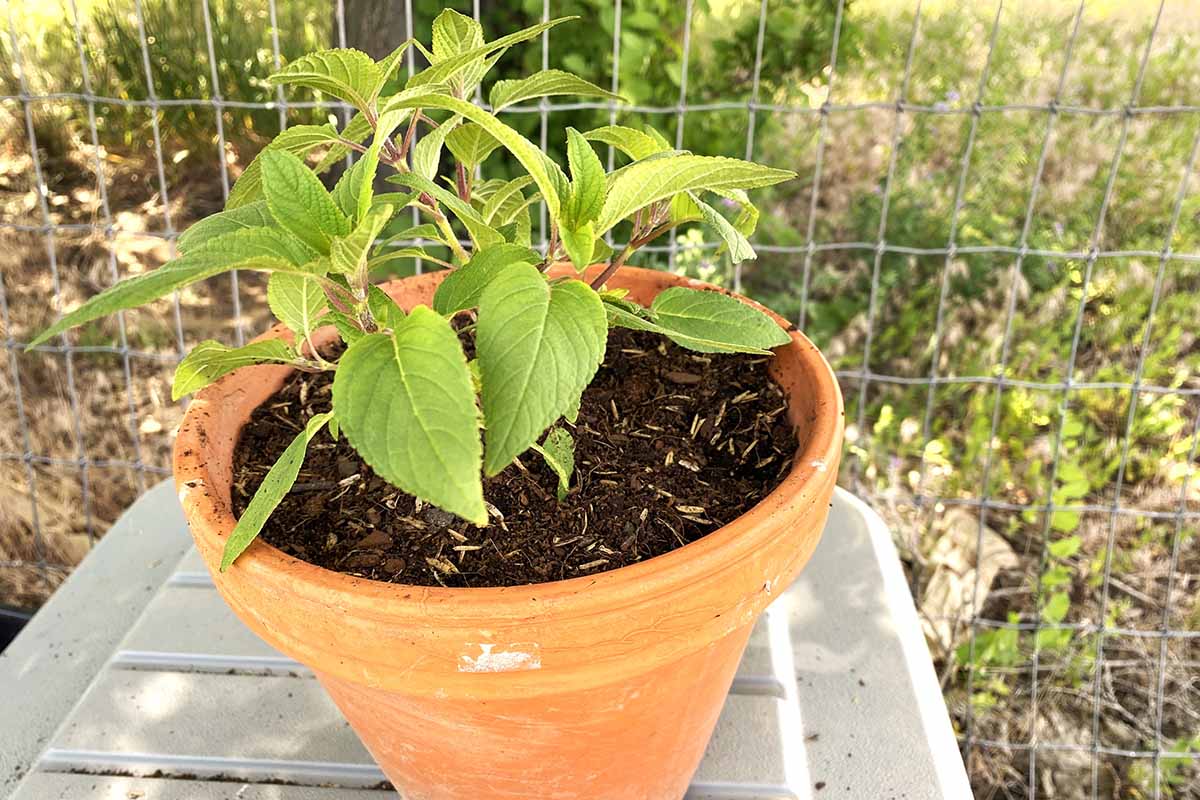
Select a three-gallon-size pot to transplant into, or something larger.
Want to learn more about container-cultivated aromatics? You can learn more about growing herbs in containers in our guide.
For specimens grown in the ground as either perennials or annuals, the transplanting process is pretty straightforward:
Clear the growing area of weeds prior to transplanting – and remember that this herb can spread to three or four feet wide, so plan accordingly when choosing your location. You may want to sketch out your plan in a gardening notebook first.
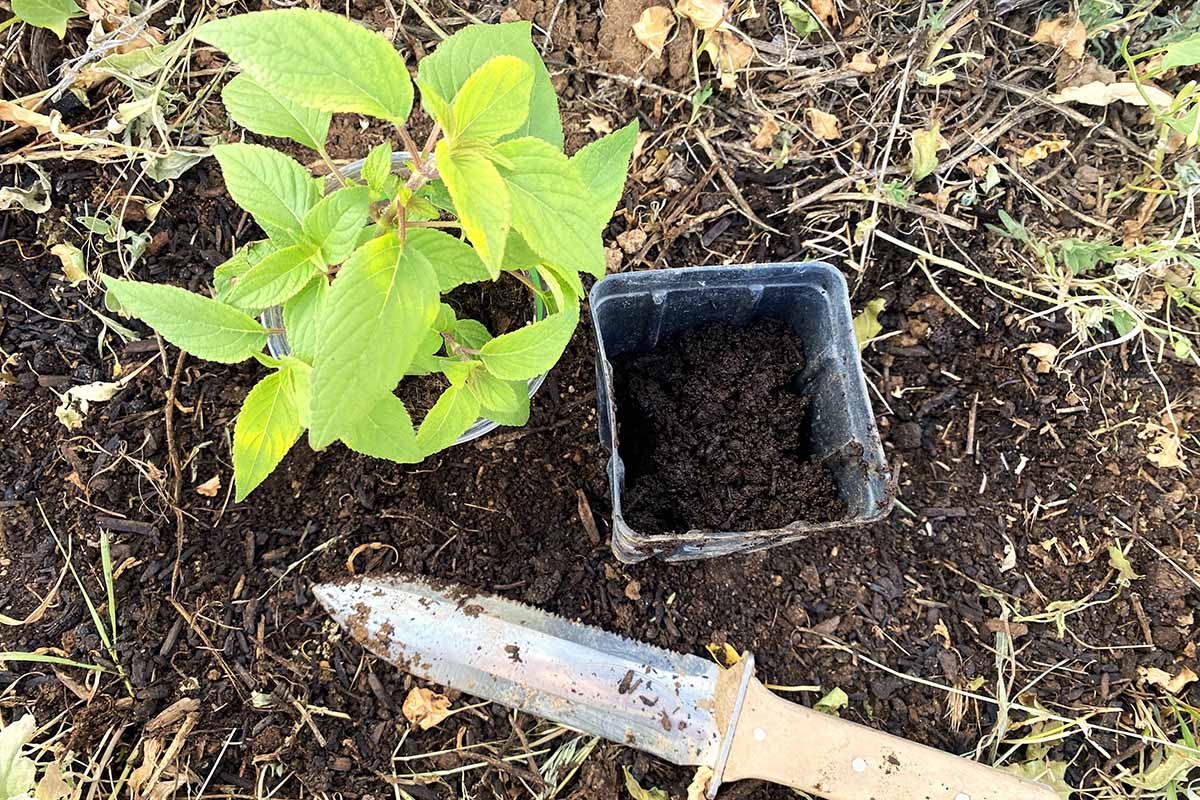
Dig a hole a couple of inches deeper than the nursery pot and twice as wide.
Throw a handful of well-rotted compost into the hole.
To remove the herb from its nursery pot, don’t pull on its foliage. Instead, squeeze the sides of the pot and tilt the plant downward to ease it out.
If a dense tangle of roots is revealed upon removing the plant from its pot, that means it’s potbound. Rub the potbound roots to try to tease them out of their snarl.
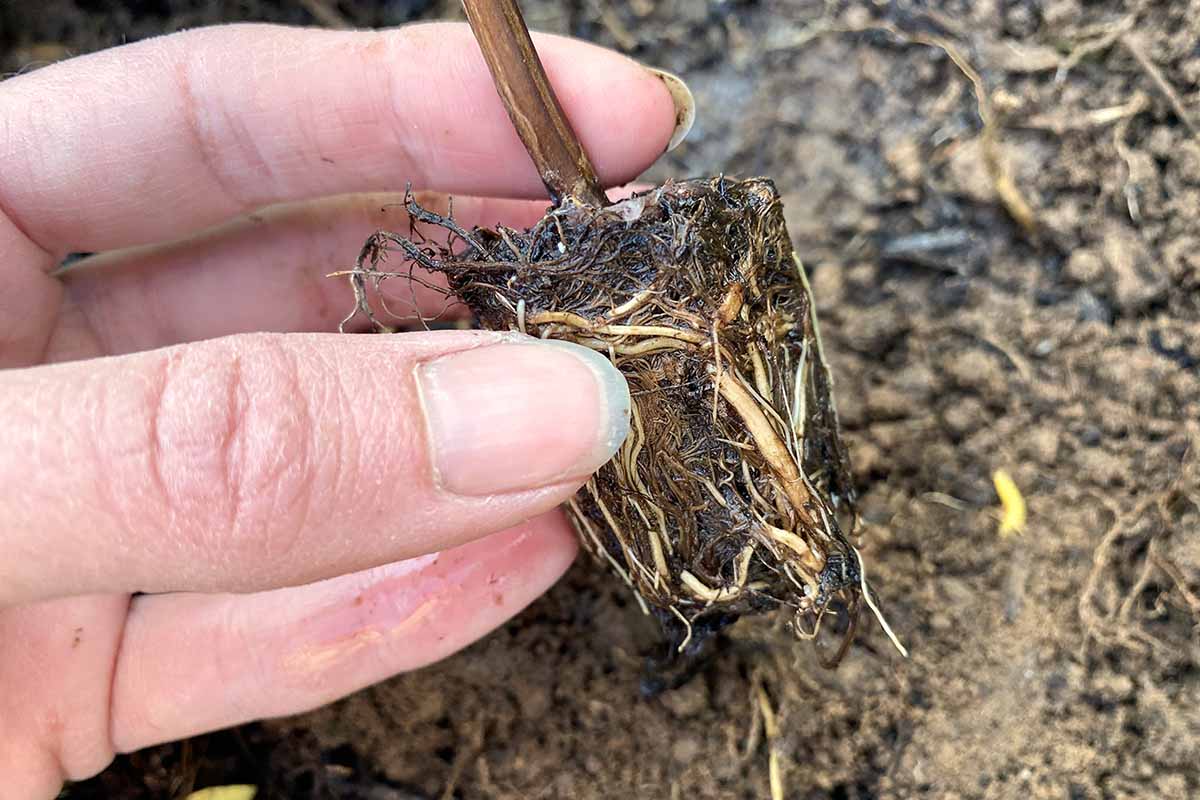
If any growing medium is released from the roots as you loosen them, put it in the hole with the compost and mix to combine.
Situate the specimen in the hole so that the top of its root ball is level with the ground – if needed, remove or add soil from under the plant to settle it at the right level.

Backfill with soil, pressing the surface lightly, then water the plant in.
Water daily for the next week or so as the herb gets established, unless it rains. In that case, you can let the clouds do the job!
How to Grow Pineapple Sage
Pineapple sage grows well in full sun, but it can also thrive in part sun with light afternoon shade, especially when weather is particularly hot.
Soil should be rich in organic matter and well-drained. Loam or sandy loam soils are best for this herb, as is a pH range between 6.0 and 8.0.
If you’re not sure what type of soil you are working with, you might want to test your garden soil.
This herb prefers moderately moist soil and is only slightly drought tolerant, so don’t plant it in your xeric landscaping. Instead, make sure to irrigate regularly if you are gardening in an arid climate or experiencing a period of drought.
Growing Tips
- Grow in full sun, or part sun with light afternoon shade.
- Make sure the soil drains well and is rich in organic matter.
- Provide regular water during dry weather.
Pruning and Maintenance
Pineapple sage is a low-maintenance plant, particularly when the herb is grown as an annual.
Placing mulch around plants will help to conserve water and keep the soil temperature lower – especially during periods of high heat.
As for pruning, there are a couple of reasons why you may want to do so selectively:
To grow bushier plants, pinch back the growing tips when plants are about six inches tall. You can use these clipped stems to propagate new plants from cuttings if you like!
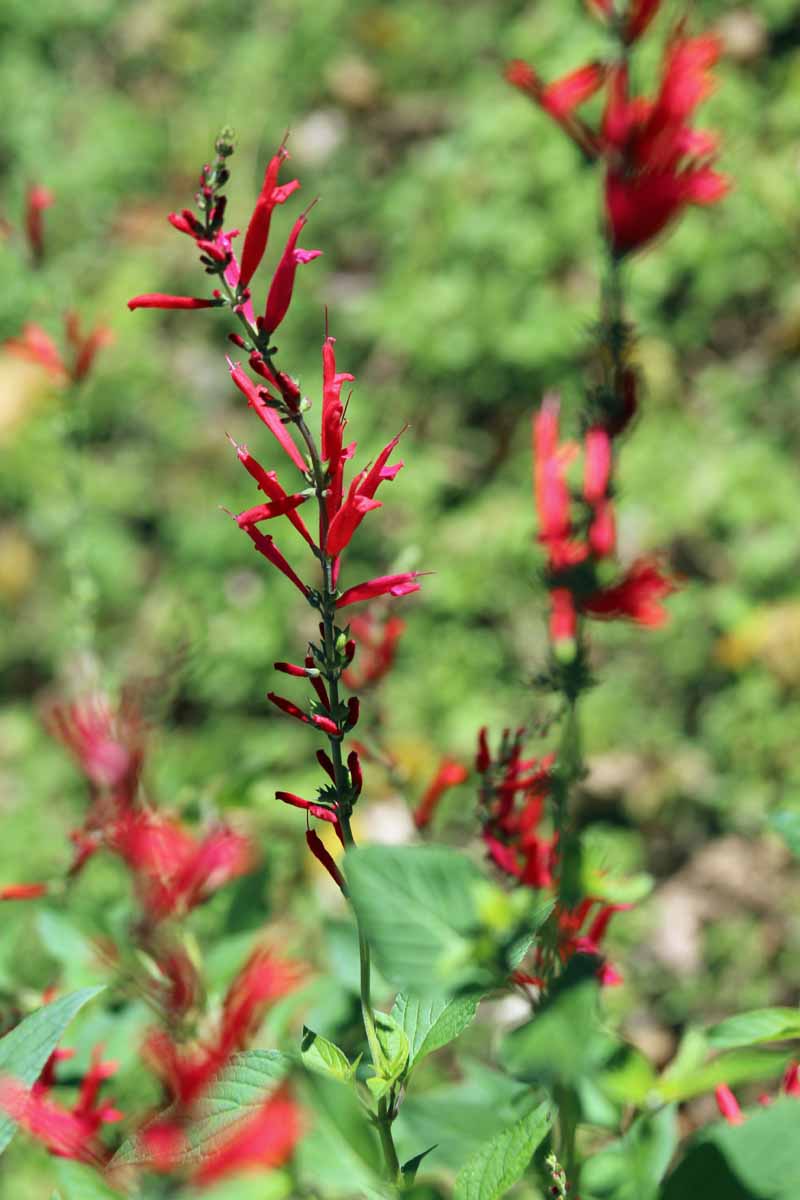
If you live in a climate with a longer growing season, you may be able to get more than one bloom period from these herbs. Once a flower spike has finished blooming, prune it back – you should get a round of new blooms soon.
Gardeners growing this plant as a perennial can fertilize it with a handful of compost offered twice a year in spring and summer. To add compost to the soil, move back the layer of mulch, rake the compost into the soil, water it in, and replace the mulch.
For those who live in an area where frosts and freezing occur, but where plants grow back from the ground each year, cut the stems back to an inch above the soil after the first killing frost.
To improve survival rates of these plants, place a three- to four-inch layer of mulch over the crowns of the plants after the first killing frost, using a lightweight mulch like straw, pine straw, or leaf mulch.
For those hoping to overwinter container-grown specimens indoors, keep in mind that this plant needs four to six hours of direct sun every day.
Place it close to a south-facing window and make sure it is getting enough sunlight each day, or supplement with grow lights.
Pineapple Sage Cultivars to Select
Pineapple sage is frequently available at garden nurseries during the summer season. If it’s not available at yours, you may be able to purchase it online.

Two-Pack of Live Pineapple Sage Plants in 3.5” Pots
For instance, you’ll find a two-pack of pineapple sage plants in three-and-a-half-inch pots available for purchase from Clovers Garden via Amazon.
If you’re interested in trying cultivars of S. elegans, here are a few to be on the lookout for:
Elk Sonoran Red
‘Elk Sonoran Red’ is a variety of S. elegans that is more compact and blooms earlier.
Frieda Dixon
‘Frieda Dixon’ is a cultivar that has pink-toned flowers, rather than red.
Golden Delicious
‘Golden Delicious’ has yellowish-toned foliage rather than green.
Honey Melon
‘Honey Melon’ is the longest and earliest flowering variety of pineapple sage. It is also quite compact, growing to one to two feet tall and wide.
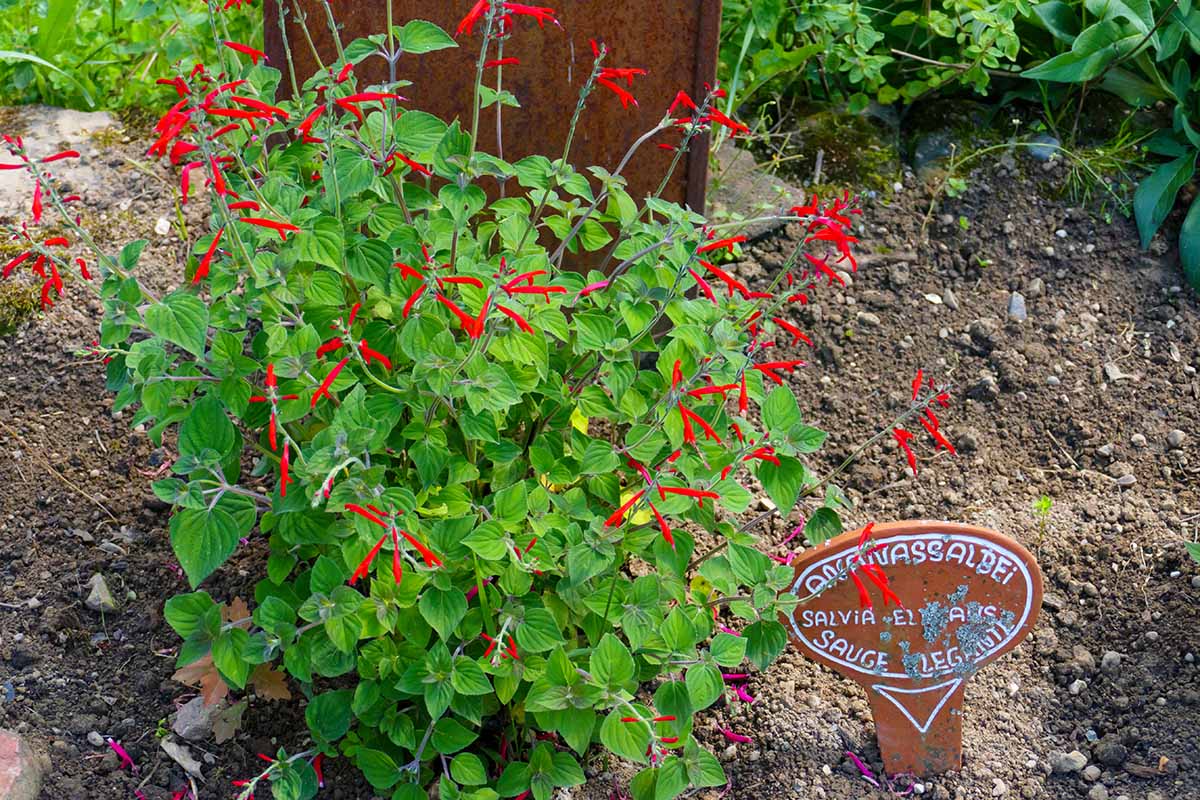
According to Betsy Clebsch, author of “The New Book of Salvias,” available on Amazon, ‘Honey Melon’ is slightly more cold hardy than the species and other cultivars.
Tangerine
‘Tangerine’ is another compact variety, maturing to one to two feet tall and two to three feet wide. Its fragrance has more of a citrus aroma than the species and it also blooms earlier.
Managing Pests and Disease
Deer and rabbits aren’t as enthralled by the tropical scent of this plant as we are, so they will tend to leave it alone if there is better eating nearby.
Insect pests don’t tend to be a problem either when growing this herb outdoors. In greenhouse settings, however, aphids, mealybugs, and spider mites can be problematic.
Though leaf spot, a disease caused by a fungal pathogen, was detected in Italy in 2017, this is not a widespread problem. Diseases are uncommon with pineapple sage.
Pineapple Sage Best Uses
I bet you’ve already got ideas of your own as to how you’d like to enjoy this bright-bloomed plant in your yard or garden.
Let’s consider some of the many different uses of this plant, just in case you’re looking for inspiration.
Interested in attracting pollinators and beneficial insects as part of your organic gardening strategy? Count pineapple sage as an excellent option to choose from.
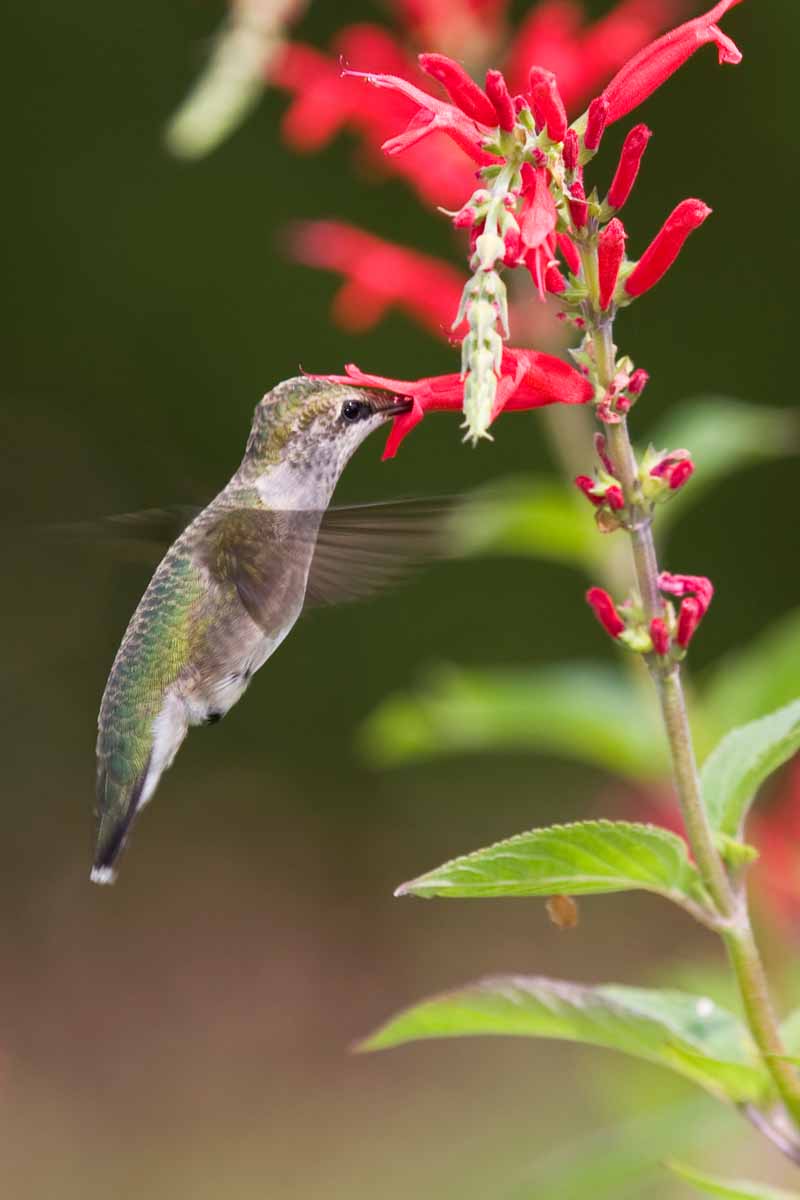
Red flowers are hummingbird magnets, so if you’re trying to provide food for visiting or resident hummingbirds, this is a plant you can include on their menu.
And if gardening for wildlife is indeed one of your priorities, since this plant grows quickly, it can fill in while you get more slow-growing native wildflowers like cardinal flower established.
Hummingbirds aren’t the only ones who enjoy these flowers – this herb can also be used as part of a butterfly garden.
And of course, pineapple sage should be included in a fragrant garden or herb garden – that should go without saying!
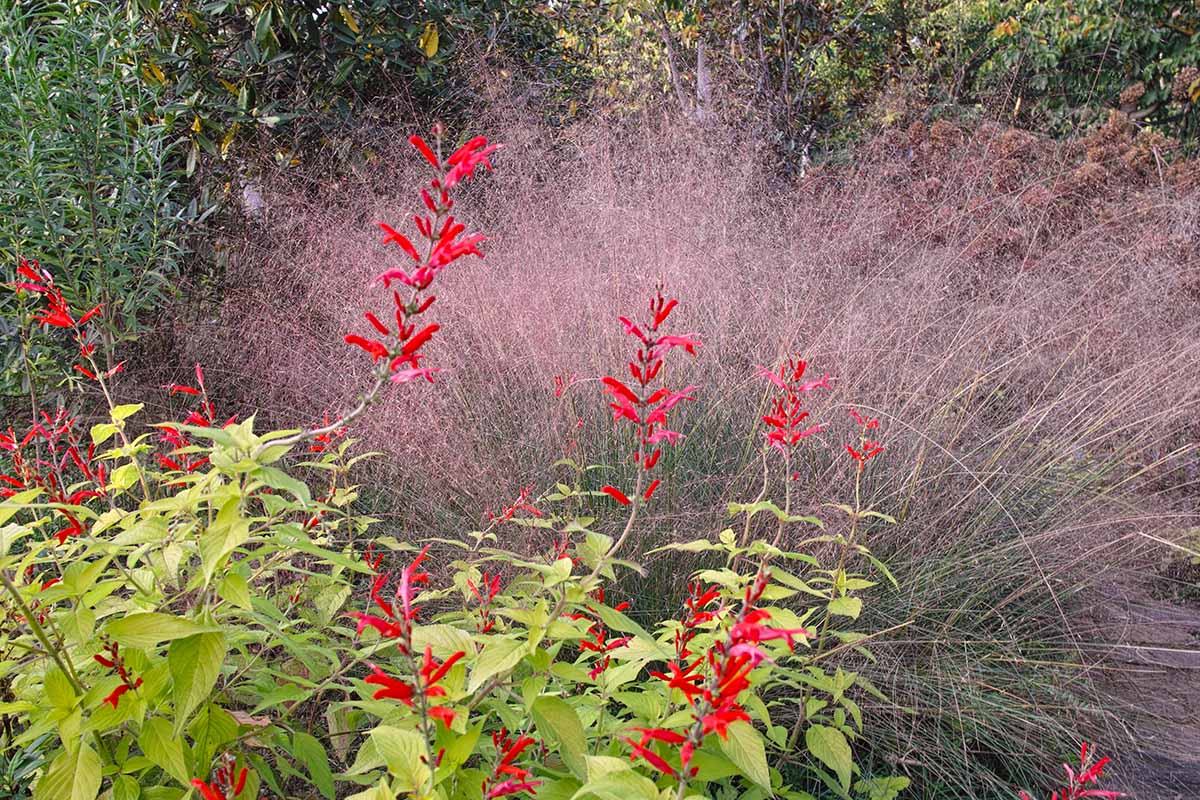
This herb makes a good background plant in a mixed border, and its height lends itself well to cottage gardens as well.
And since its bright red blooms stick around until the last frost, it can be used to put some color into your fall landscaping too.
Quick Reference Growing Guide
| Plant Type: | Semi-woody subshrub or tender herbaceous perennial | Flower/Foliage Color: | Red/light green |
| Native to: | Guatemala, Mexico | Maintenance: | Low |
| Hardiness (USDA Zones): | 8-10 | Tolerance: | Afternoon shade |
| Bloom Time/Season: | Summer, fall | Soil Type: | Loam, sandy loam |
| Exposure: | Full sun, part shade | Soil pH: | 6.0-8.0 |
| Time to Maturity: | 3-4 months | Soil Drainage: | Well-draining |
| Spacing: | 1-4 feet | Attracts: | Bees, butterflies, hummingbirds |
| Planting Depth: | Top of root ball level with soil (transplants) | Companion Planting: | Hot peppers, marigolds, Mexican mint, nasturtiums |
| Height: | 1-5 feet | Avoid Planting With: | Garden cress, radishes |
| Spread: | 1-4 feet | Uses: | Borders, butterfly gardens, cut flower gardens, edible gardens, fragrant gardens, herb gardens, hummingbird gardens |
| Growth Rate: | Fast | Family: | Lamiaceae |
| Water Needs: | Moderate | Genus: | Salvia |
| Common Pests and Disease: | Aphids, mealybugs, spider mites, whiteflies; leaf spot | Species: | Elegans |
Grow the Elegant Sage
A little elegance is never a bad thing, especially when it’s combined with the sensual delight of pleasing smells and blooms you just can’t ignore.
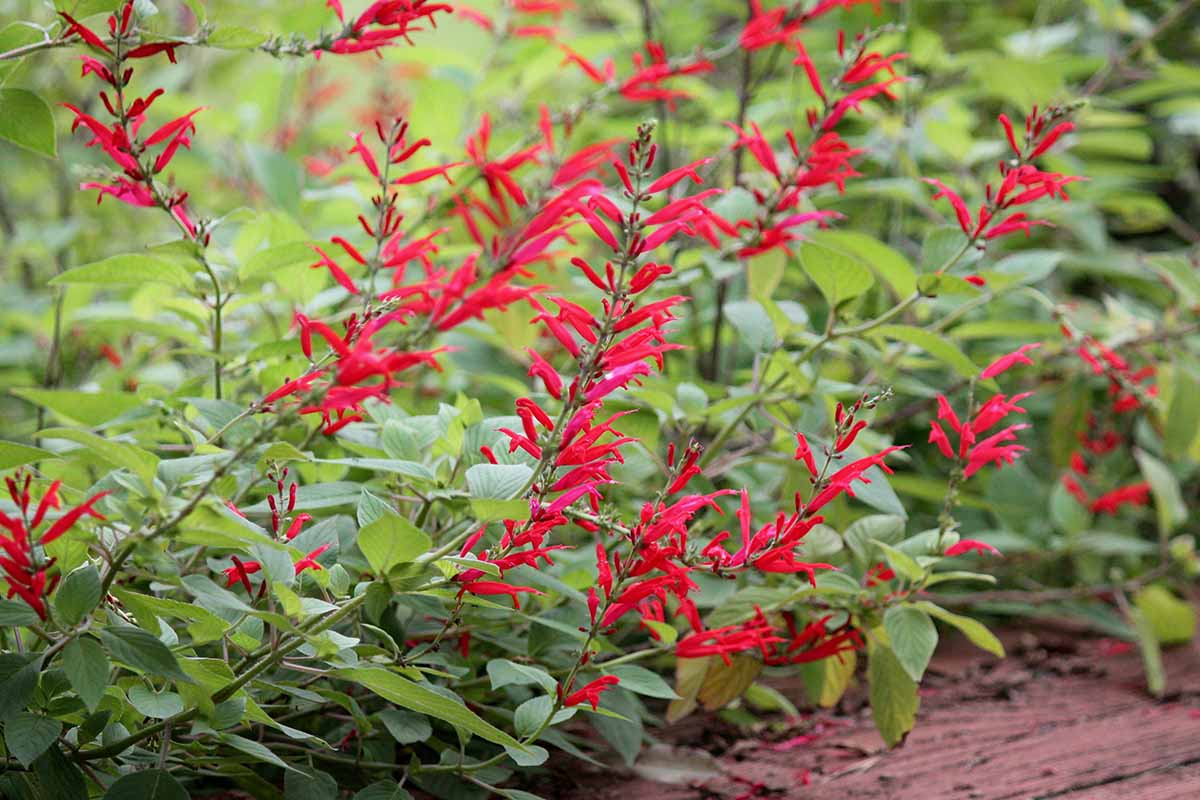
Does pineapple sage make you sigh out of pure bliss? What’s your favorite way to use its leaves or flowers in food or beverages? Any other questions or comments to share? Let us know in the comments section below.
Now that you have mastered the art of cultivating S. elegans, would you care to learn more about growing salvias? Keep reading right here:
